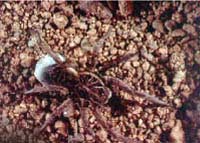
Integrated pest management (IPM) uses natural predator insects and or diseases to control many problem insects. The full range and degree of activity of predators in Lao coffee is not yet known. Preliminary surveys have indicated the presence of a number of predators with spiders being the most common.
There is no set procedure for IPM, but a critical first step is switching from scheduled sprays to strategic sprays based on crop monitoring results. IPM can appear to be a higher risk and more complex way of managing pests and diseases. However, if done well, it can effectively cut costs and reduce damage to the environment and bio-diversity by overuse of chemicals
Spiders

Wolf spider

Lynx spider
Wolf spiders (Lycosa spp.) are common soil predators, whereas flower spiders, lynx spiders (Oxyopes spp.), jumping spiders, orb weavers (Agriope calenulta) and many others are active predators in plant canopies. Spiders will prey on most insects including moth and butterfly eggs, small and large caterpillars and aphids. It is common for a crop grown with minimal or no sprays to have a spider's web on almost every plant.
Dwarf spider (Atpena spp.) Dwarf spiders are dark-coloured and tiny (less than 2 mm long), prey on mites and small insects. They are active during the day and make sheet or dome shaped webs on leaf and soil surfaces.
Harvestmen (Phalangida) is a spider-like insect.
Tachinid fly

Tachinid fly. Adult attacking a caterpillar
Tachinid flies (Argyrophylax nigrotibialis) are grey-black and slightly bigger than a housefly. They lay their eggs either on foliage on which caterpillars feed, or directly into the body of the caterpillar. The fly larva bores into the caterpillar and attaches to the skin, leaving a breathing hole. The larva then grows inside the caterpillar, eventually killing it and forming a brown, oval pupal case from which the adult fly emerges.
Braconid wasp

Apanteles. Cocoons attached to dead host
Braconid wasps (Apanteles spp.) grow up to 12 mm in length. They parasitize a broad range of hosts: caterpillars, flies, wasps, beetles and aphids. After a female injects an egg into a host, the larva feeds slowly on that single host. When the host dies, the fully grown larva pupates inside or near the dead host, sometimes in a silken cocoon, to emerge later as an adult wasp.
These predators are seen in small numbers.
Praying mantis
The Carolina mantid (Stagmomantis carolina) grows to about 4 to 7 cm in length with a large head and abdomen. The body color is a tannish-brown with light green wings. They have a pair of large forelegs that are serrated and spiny and folded back like a pocket knife.
Lacewings

Brown lacewing. Adult lacewing (top), larva (left) and alphids

Green lacewing. Larva camouflaged with frass (left) and adult (below)
Lacewing (Chrysopa spp.) species include the brown (Micromus spp.) and the green (Mallada spp.) lacewings The larvae are predators especially of aphids. The brown lacewing adult has brown wings and larvae are brown with white markings. Eggs are laid singly on leaves. Green lacewing adults are slightly larger than brown lacewing adults. Eggs are laid on stalks attached to the plant. Green lacewing larvae are squat and pale brown and they camouflage themselves with the carcasses of their prey.
Damsel bug

Damsel bug adult
The damsel bug (Nabis kinbergii), preys on soft-bodied insects such as aphids, jassids, caterpillars and moth and butterfly eggs. Damsel bugs are brown, thin and up to 10 mm long.
Stick insect
Walking-stick insects (Pseudophasma spp.) are among the largest insects in the world reaching over 30 cm long. Most stick insects are tropical and nocturnal. During the day, many of them lie dormant surrounded by the sticks and leaves they resemble.
Green lacewing eggs


